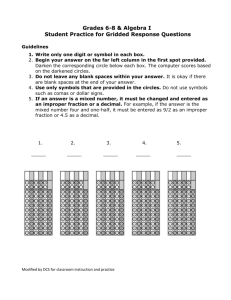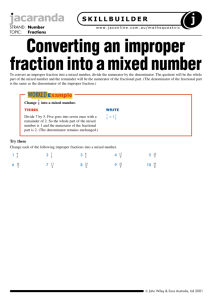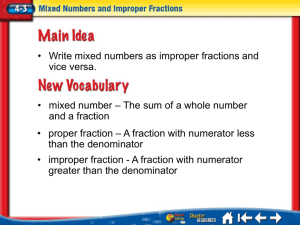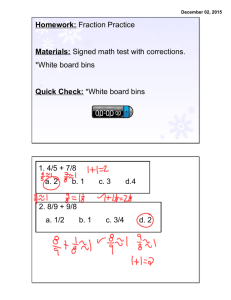Topic: Creating Mixed Numbers and Improper Fractions SOL: 5.7
advertisement
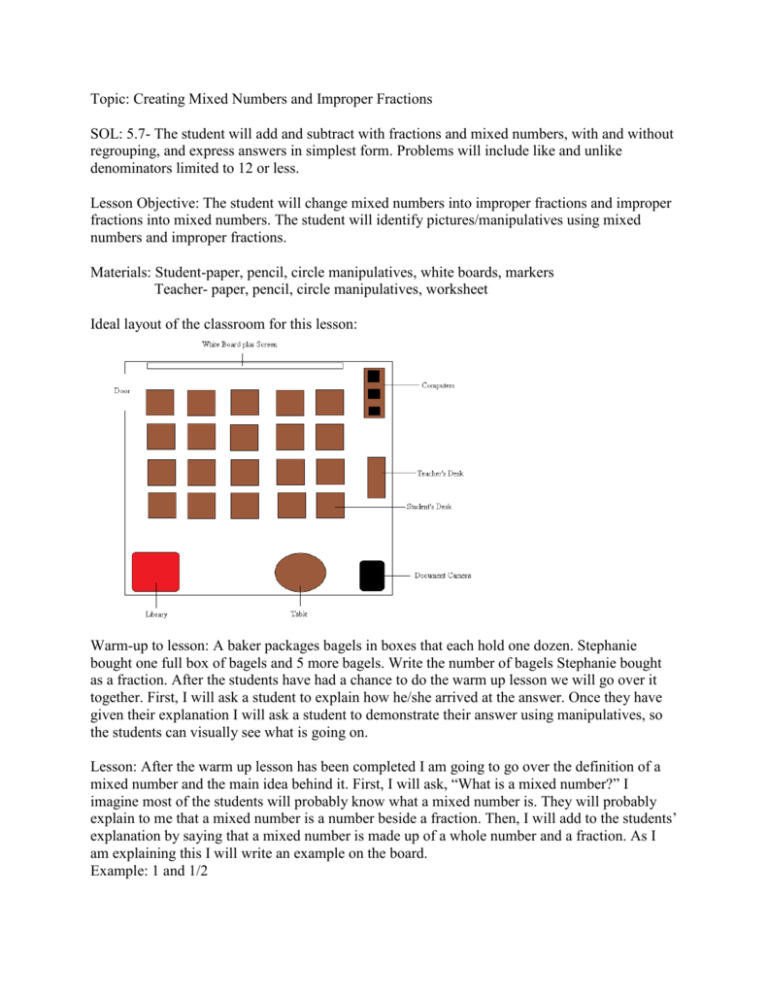
Topic: Creating Mixed Numbers and Improper Fractions SOL: 5.7- The student will add and subtract with fractions and mixed numbers, with and without regrouping, and express answers in simplest form. Problems will include like and unlike denominators limited to 12 or less. Lesson Objective: The student will change mixed numbers into improper fractions and improper fractions into mixed numbers. The student will identify pictures/manipulatives using mixed numbers and improper fractions. Materials: Student-paper, pencil, circle manipulatives, white boards, markers Teacher- paper, pencil, circle manipulatives, worksheet Ideal layout of the classroom for this lesson: Warm-up to lesson: A baker packages bagels in boxes that each hold one dozen. Stephanie bought one full box of bagels and 5 more bagels. Write the number of bagels Stephanie bought as a fraction. After the students have had a chance to do the warm up lesson we will go over it together. First, I will ask a student to explain how he/she arrived at the answer. Once they have given their explanation I will ask a student to demonstrate their answer using manipulatives, so the students can visually see what is going on. Lesson: After the warm up lesson has been completed I am going to go over the definition of a mixed number and the main idea behind it. First, I will ask, “What is a mixed number?” I imagine most of the students will probably know what a mixed number is. They will probably explain to me that a mixed number is a number beside a fraction. Then, I will add to the students’ explanation by saying that a mixed number is made up of a whole number and a fraction. As I am explaining this I will write an example on the board. Example: 1 and 1/2 I will follow up the example with the question “What is an improper fraction?” Once again, I expect the students to know what an improper fraction is. The students probably will tell me that an improper fraction is a fraction, where the numerator is greater than the denominator. I will then add on to what they are saying by telling them an improper fraction is a fraction that is greater than 1. I will continue to explain that an improper fraction can also be renamed as a mixed number and a mixed number can be renamed as a fraction. Example: 1 and 1/2 = 3/2 Before I go into detail of the above example I will remind the students what a denominator and a numerator represents. I will tell them that a denominator represents the number of equal parts in a whole and the numerator represents the number of pieces being discussed. Then I will ask, “What type of fraction is 1 and 1/2?” After I get the correct answer from the students I will then have them help me explain the mixed number, 1 and 1/2. I will follow up their answers with the question “What does the 1 represent in 1 and 1/2?” I imagine the students will say that the 1 represents a whole. But, I want them to say more than that which is why I would ask, “What does the whole represent?” My goal is to get the students to understand that the 1 is made up of two halves. I want them to verbally say it out loud. Next, I will ask, “Can someone explain to me what the 1/2 represents?” Again, I want the students to understand that 1/2 is just 1 of the halves remaining. As I am going over the example I will hold up manipulatives, so the students can visually see what we are talking about. I will show them 1 whole of a circle to represent the 1. Then, I will show them a half of a circle, which represents 1/2. We will then move onto improper fractions. I will address the class by asking, “What type of fraction is 3/2?” Then, I will ask “What does 3/2 represent?” My goal is to get the students to understand that 3/2 is really 3 pieces of halves. Once again, I will use the same 3 pieces of the circle to demonstrate 3/2. I will then follow the explanation by asking, “Can someone explain to me what three halves means in terms of the definitions we discussed earlier about numerator and denominator?” My ideal answer I am looking for is that the fraction has 3 pieces being discussed and there are 2 equal parts in a whole. I will then go over another example with the students. Example: 1 and 1/3 = 4/3 After I go over a couple of examples I will pass out manipulatives to the students, so they can work through the examples with me. The manipulatives I will use will be the circles with fractions written on them. Depending on how many manipulatives I have I will have the students pair off or work alone. The first example I will have the students work on is 2 and 1/2. Before the students begin the example I will ask, “What does 2 and 1/2 represent or mean?” I expect the students should know that it represents 2 whole pieces with one of the halves remaining. Next, I will have them use their manipulatives to create 2 and 1/2. Then I will ask, “How can we change 2 and 1/2 into an improper fraction?” If the students are going to struggle anywhere in the lesson this is where I would expect them to struggle. If the students do struggle I will tell them to count the number of halves they have using their manipulatives from the mixed number they constructed. I anticipate that all the students will tell me they counted 5 halves. Then, I will give an energetic response explaining to them that they just created an improper fraction. I will show them that 2 and 1/2 represents the same amount as 5/2. I want them to understand that if they counted the number of halves from the manipulatives they used to create the mixed number, they can easily create an improper fraction. The only difference between the mixed number and improper fraction is the way they are written. After we go over 5/2, then we will continue to go over more examples. For the following examples I want the students to continue using the circles to construct the mixed number. Then I want them to create an improper fraction by manipulating their circles. The next two examples the students will do by themselves or with a partner. As they finish each example I will have them write an equivalent improper fraction on a white board. Examples: 1 and 2/3 2 and 1/3 After we go over the above examples I will then give the students a worksheet to work on. I do not expect them to finish all the examples in class, but I figured it would not hurt to give them extra practice. After the students have had time to work on the worksheet we will then go over some of the answers together and then move onto the reflection. Reflection: I will have the students talk with a partner about what they found interesting and what they learned today. Sample Assessment: A baker packages bagels in boxes that each hold one dozen. Stephanie bought one full box of bagels and 5 more bagels. Write a mixed number and an improper fraction for the amount of bagels Stephanie bought. NAME__________________ Write a mixed number and a fraction for each. 1. 2. Write each mixed number as a fraction. Hint: Use your circles. Explain why your answer to number 3 makes sense. 3. 4. Write each fraction as a mixed number. 5. 5 2 6. 10 3 More Practice Write each mixed number as a fraction. Hint: Use circles. If you do not have any circles you could always draw some. 7. 8. 9. 10. 11. Write each fraction as a mixed number. 12. 6 4 13. 7 2 14. 11 8 Notes: I will have to draw in Source for word problems Nelson, R. (2009). Fun Food Word Problems Starring Fractions. 12-14



